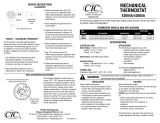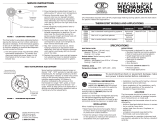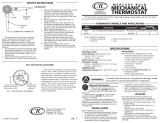Page is loading ...

Installation Instructions for
Heating & Cooling
Model 350
WHITE-RODGERS
CONTENTS
Preparations........................................... 1
Thermostat Features.............................. 2
Removing Old Thermostat ..................... 3
Mounting and Wiring .............................. 4
Set Heat Anticipator ...............................5
New Thermostat Operation .................... 6
Specifications ......................................... 7
Troubleshooting ..................................... 8
PREPARATIONS
THERMOSTAT FEATURES
REMOVING OLD THERMOSTAT
Before removing wires from old thermostat’s switching subbase,
label each wire with the terminal designation it was removed from.
1. Remove Old Thermostat: A standard heat/cool thermostat
consists of three basic parts:
a. The cover, which may be either a snap-on or hinge type.
b. The base, which is removed by loosening all captive screws.
c. The switching subbase, which is removed by unscrewing
the mounting screws that hold it on the wall or adaptor plate.
Make a note here of the anticipator setting on
the old thermostat for future reference and use in step 5.
The heat anticipator pointer, if adjustable, will be set at one of a
series of numbers representing the current rating of the primary
control in your furnace. The number will be one of the following:
.2, .4, .8, etc. or 0.2, 0.4, 0.8, etc.
If no heat anticipator/indication is showing, do not be concerned;
move on to the next step.
To prevent electrical shock and/or equipment damage,
disconnect electrical power to the system at the main
fuse or circuit breaker until installation is complete.
CAUTION
!
Printed in U.S.A.
PART NO. 37-6237A
0116
WHITE-RODGERS
EMERSON ELECTRIC CO.
9797 REAVIS ROAD
ST. LOUIS, MISSOURI 63123-5398
www.white-rodgers.com
Failure to follow and read all instructions carefully be-
fore installing or operating this control could cause
personal injury and/or property damage
Assemble tools required as shown below.
YOUR THERMOSTAT REPLACES
1
2
3
WIRE CUTTER/STRIPPER
FLAT BLADE SCREWDRIVER
HAND OR POWER
DRILL WITH 3/16 INCH
DRILL BIT, IF NEEDED
Description 350
Standard Heat & Cooling Systems – 4 or 5 wires Yes
Standard Heat Only Systems Yes
Millivolt Heat Only Systems – Floor or Wall Furnaces Yes
Standard Central Air Conditioning Yes
Gas or Oil Heat Yes
Electric Furnace Yes
Hydronic (Hot Water) Zone Heat – 2 Wires Yes
Hydronic (Hot Water) Zone Heat – 3 Wires No
Heat Pump (No Aux or Emergency Heat) Yes
Heat Pump (with Aux or Emergency Heat) No
Baseboard Electric Heating or Line Voltage (120 or 240 volt) No
SPIRIT LEVEL OR PLUMB BOB AND LINE—
THERMOSTAT MUST BE LEVEL TO WORK PROPERLY
Figure 1.
MOUNTING
SCREWS
ANTICIPATOR
BASE
COVER
MOUNTING
SCREWS
KEEP THIS AREA
CLEAR OF WIRES
SWITCHING
SUBBASE
90
80
70
60
50
90
80
70
60
50
AUTO
FAN
ON
COOL
SYSTEM
OFF
HEAT

Model 350 (Heating and Cooling):
A. Remove base from subbase: Loosen the three screws on
the base and remove.
B. Mount switching subbase: Use the screws provided to mount
the subbase to wall (see Fig. 1).
C. Attach wires to appropriate terminals:
• For two wire systems (Heat Only or Cool Only). If you
have a two-wire Heat Only system, attach one wire to RH and
one to wire W. If you have a two-wire Cool Only system, attach
one wire to RC and one to wire to Y. Leave the factory
installed jumper between RC and RH attached. Tighten any
unused terminals securely.
• If your system has more than two wires: Use the cross
reference chart to determine correct wire connections. If you
have a four-wire heat/cool system leave the factory installed
jumper between RC and RH attached (see Fig 2.). If your
system has five wires remove the factory installed jumper
between RC and RH (see Fig 3.).
• Electric heat or single stage heat pump systems: This
thermostat is configured from the factory to operate a heat/
cool, fossil fuel (gas, oil, etc.) forced air system. It is configured
correctly for any system that DOES NOT require the thermo-
stat to energize the fan on a call for heat. If your system is an
electric heat or heat-pump system that REQUIRES the ther-
mostat to turn on the fan on a call for heat, remove the yellow
factory-installed jumper wire from the Y terminal and connect
MOUNTING AND WIRING
Take care when securing and routing wires so they do
not short to adjacent terminals or rear of thermostat.
Personal injury and/or property damage may occur.
CAUTION
!
ATTENTION! This product contains mercury. There will not be
any exposure to mercury under normal conditions of use. This
product may replace a unit which contains mercury.
Do not open mercury cells. If a cell becomes damaged, do not
touch any spilled mercury. Wearing non-absorbent gloves, take
up the spilled mercury and place into a container which can be
sealed. If a cell becomes damaged, the unit should be disgarded.
Mercury must not be discarded in household trash. When the unit
this product is replacing is to be discarded, place in a suitable
container and return to White-Rodgers at 9797 Reavis Road, St.
Louis, MO, 63123-5398 for proper disposal.
REMOVING OLD THERMOSTAT
CONTINUED FROM FIRST PAGE
WARNING
!
Do not use on circuits exceeding specified voltage.
Higher voltage will damage control and could cause
shock or fire hazard.
Do not short out terminals on gas valve or primary
control to test. Short or incorrect wiring will damage
thermostat and could cause personal injury and/or
property damage.
Thermostat installation and all components of the sys-
tem shall conform to Class II circuits per the NEC code.
TERMINAL CROSS REFERENCE CHART
New Thermostat
Terminal Designation
Other Manufacturers’
Terminal Designation
RH
RC
G
W
Y
4
R
G
W
Y
RH
R
G
W
Y
M
V
F
H
C
R5
-
G
4
Y6
R
-
G
W
Y
**
* These are four-wire, single-transformer systems.
Factory installed jumper wire between the RH
and RC terminals must remain in place.
it to the A terminal. This will allow the thermostat to energize
the fan immediately on a call for heat. If you are unsure if the
heating system requires the thermostat to control the fan,
contact a qualified heating and air conditioning service person.
For single stage heat pump applications (no auxillary heat),
install a short jumper wire (not included) across terminals
W and Y. If the system has a reversing valve connection
energized in Cooling, attach it to O. If the system has a
reversing valve connection energized in Heating, attach it to B
(see Fig. 4). This thermostat will not provide multi-stage
heating or cooling.
D. Mount Thermostat Base: Gently push excess wire back into
the wall opening and plug hole with a fire-resistant material,
such as fiberglass insulation to prevent drafts from affecting
thermostat operation. Mount the thermostat base to the sub-
base using the three captive screws on the thermostat base.
(see Fig. 1) Tighten the screws securely. Proceed to Step #5.
RH W B O Y G RC A
24 VAC
120 VAC
Hot
Neutral
TRANSFORMER
Heat
Relay
Compressor
Relay
Fan
Relay
Factory-Installed Jumper
Figure 2. Typical wiring for single transformer
heating/cooling system
Figure 3. Typical wiring for two-transformer
heating/cooling system
RH W B O Y GA
24 VAC
120 VAC
Hot
Neutral
TRANSFORMER
Heat
Relay
Compressor
Relay
Fan
Relay
24 VAC
120 VAC
Hot
Neutral
TRANSFORMER
RC
Figure 4. Typical wiring for single transformer,
single stage heat pump system
W BO YG A
24 VAC
120 VAC
Hot
Neutral
TRANSFORMER
Compressor
Relay
Fan
Relay
* * *
Factory-Installed Jumper
* * *
Terminal energized
in cooling
Terminal energized
in heating
RH
Field-Installed Jumper
RC
www.white-rodgers.com
4
3

SET HEAT ANTICIPATOR
Set anticipator to match the setting of your old thermostat you
noted in Step 3, or, the anticipator should be set to match the
current rating stamped on your main heating control. The heat
anticipator is adjustable from 0.15 to 1.2 amps. Adjust the antici-
pator by rotating the contact arm (see fig. 5). The anticipator
setting is indicated by the numbers on the base that the pointer
points to. If you are unsure where to set the anticipator contact the
heater manufacturer for a recommended setting.
Move the pointer counterclockwise to lengthen heating system
cycles; move clockwise to shorten heating cycles. Adjustments
should not be greater than 1/2 marking at a time.
Snap on Cover: Carefully align the cover with the base and snap
the cover onto the base.
NEW THERMOSTAT OPERATION
This thermostat is easy to operate. Fig. 6 shows how the heating/
cooling system and fan operate when the switches are in various
positions. Use the system switch to select either heating or
cooling, or to turn the heating/cooling system off. Use the fan
switch to control fan operation. When the fan switch is in the
AUTO position, the fan will cycle with the heating or cooling
system (the fan will not run if the system switch is in the OFF
position and the fan switch is in the AUTO position). When the fan
switch is in the ON position, the fan will run continuously, regard-
less of system switch position (even if the system switch is set to
OFF, the fan will run if the fan switch is in the ON position).
ELECTRICAL DATA
Switch Rating ........................24 VAC (30 VAC max.)
Heating....................................0.15 to 1.2 Amps
Cooling ....................................0 to 1.5 Amps
Switch Action ........................SPST – Sealed mercury switch
Anticipator Rating:
Heating ....................................Adjustable from 0.15 to 1.2 Amps
Cooling ....................................Fixed
SPECIFICATIONS
THERMAL DATA:
Temperature Range ..............50°F to 90°F (10°C to 32°C)
Operating Humidity Range...0 – 90% noncondensing
24VAC
50/60 Hz
.35 Amps
Typical Zone Valve
24VAC
50/60 Hz
.23 Amps
Typical Gas Valve
24VAC
50/60 Hz
.43 Amps
Typical Oil Primary
www.white-rodgers.com
5
6
7
.18
.25
.3
.4
.2
.15
1.
.8
.6
.5
Arrow points to the
current rating of the
primary control
Move this lever to
adjust heat
anticipator
Figure 5. Anticipator adjustment
L
O
N
G
E
R
C
Y
C
L
E
S
FAN
AUTO ON
SYSTEM
COOL OFF HEAT
Shows switch position
OPERATION
No heating; no cooling; no fan
No heating; no cooling; fan runs continuously
Cooling system cycles from thermostat; fan runs
continuously
Cooling system and fan cycle from thermostat
Heating system cycles from thermostat; fan cycles
from fan control on furnace
Heating system cycles from thermostat; fan runs
continuously
Figure 6. Subbase switching and thermostat/system operation

Symptom Possible Cause Corrective Action
No Heat/No Cool/No Fan 1. Blown fuse or tripped circuit breaker. Replace fuse or reset breaker.
(common problems) 2. Furnace power switch to OFF. Turn switch to ON.
3. Furnace blower compartment door or Replace door panel in proper position to engage
panel loose or not properly installed. safety interlock or door switch.
No Heat 1. Pilot light not lit. Re-light pilot.
2. Broken or melted anticipator wire. Excessive current or dead short in system. Have
a qualified service person check the system
before replacing thermostat.
3. Loose connection to thermostat or system. Verify thermostat and system wires are securely
attached.
4. Thermostat or heating system requires Your furnace manufacturer or service person can
replacement or service. describe how to test the heating system to verify
it is operating correctly. If the heating system is
capable of operation and the no heat condition
persists, replace the thermostat.
5. System Switch not set to Heat. Set System Switch to Heat and raise temp above
room temp.
Intermittent Heat 1. Furnace Lock-Out Condition Many furnaces have safety devices that shut the
system down when a lock-out condition occurs. If
the heat works intermittently contact the furnace
manufacturer or local service person for assistance.
No Cool 1. Loose connection to thermostat or system. Verify thermostat and system wires are securely
attached.
2. Thermostat or cooling system requires Your cooling system manufacturer or service
replacement or service. person can describe how to test the cooling
system to verify it is operating correctly. If the
cooling system is capable of operation and the no
cooling condition persists, replace the thermostat.
3. System Switch not set to Cool. Set System Switch to Cool and lower temp below
room temp.
Heat, Cool or Fan Runs Constantly. 1. Possible short in wiring. Check each wire connection to the thermostat to
2. Possible short in thermostat. verify it is neatly looped under the terminals. No
3. Possible short in heat/cool/fan system. extra wire should stick out from under the
terminals. As an added layer of insulation put a
piece of electricians tape across the terminals on
the subbase.
Furnace Cycles Too Fast or Too Slow See Step 5, Adjusting the Anticipator. The anticipation setting is the only adjustment that
Narrow or wide temperature swing effects the heating cycle rate. If an acceptable
cycle rate is not achieved using the anticipator
contact a local service person for additional
suggestions. The location of the thermostat, size
of the Heat/Cool System and current draw can
influence the cycle rate.
Cooling Cycles Too Fast or Too Slow 1. Poor thermostat location for sensing room The cycle rate for cooling can not be adjusted.
(narrow or wide temperature swing) temperature. The location of the thermostat, size of the Cool
2. Cooling system over or undersized. system and current draw can influence the cycle
3. Excessive Current draw influencing thermostat. rate. Contact a local service person for suggestions.
Thermostat Setting and Thermostat 1. Thermostat thermometer setting requires The thermometer can be adjusted by using a
Thermometer Disagree adjustment. standard slotted screwdriver. Turn the thermom-
2. Thermostat setting lever requires calibration. eter pointer screw located inside the front cover
to change the setting. For calibrating the setting
lever contact a local heating and cooling service
person.
Adjusting Thermometer 1. Thermostat thermometer disagrees with The thermometer on the thermostat is accurately
other room thermometers. calibrated at our factory but you can adjusted it
by using a standard slotted screwdriver. Turn the
thermometer pointer screw located inside the
front cover to change the setting.
TROUBLESHOOTING
www.white-rodgers.com
8
/



